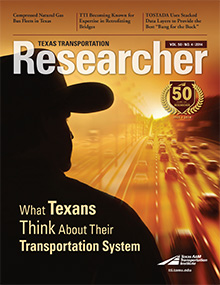When looking to buy a home, you’re more likely to get the most bang for your buck when a lot of houses are on the market. The bigger the market, the more likely a seller is to accommodate how much you want to spend, right? It’s simple supply and demand.
Similarly, when travel demand exceeds roadway capacity, the result is costly traffic congestion. The No. 1 culprit for traffic congestion is single-occupancy vehicle (SOV) travel — our reliance on driving ourselves wherever and whenever we want to go. Bumper-to-bumper traffic at peak travel times, like during morning and afternoon commutes, is often the result.
The Texas A&M Transportation Institute’s (TTI’s) Transportation Policy Research Center recently identified effective alternative strategies that can help Texas increase mobility by encouraging drivers to consider alternatives to SOV travel, even as Texas adjusts to changing demographics and emerging technologies.
To illustrate how much SOV travel contributes to congestion, researchers examined travel patterns of state employees in Austin, explains Stacey Bricka, manager of TTI’s Mobility Management Program. Their travel patterns reflect typical commutes.
Researchers have updated the demand management toolbox with readily understood best practices for decision-makers to consider. Some strategies currently used by cities include programs promoting:
- Commute solutions that emphasize commuting alternatives (e.g., flexible work schedules and carpools).
- Park-and-ride options, where commuters park their cars securely in a communal lot and ride trains/buses or carpool to and from work.
- Vanpools that provide a formal arrangement (compared to less-formal carpools) in which seven to 15 individuals share a common vehicle.
- Shared-use mobility that promotes ride-sharing to reduce the costs associated with, for example, high-occupancy toll lanes.
- Telework arrangements that allow employees to regularly work from home or an alternative location.
Some regions rely heavily on trip-reduction ordinances that mandate a reduction in SOV travel. Others have achieved statistically significant reductions in vehicle-based travel through tailored programs that educate households about their travel options and use travel surveys to document changes in mode usage over time. This tailored approach captures the societal shift to much busier schedules.
“For many commuters — especially parents — going to work is just one part of a hectic day,” says Bricka. “They have to juggle kids, doctor’s appointments and other commitments, so tailored marketing efforts help educate them about alternative travel modes for when the kids are at camp, or to get around on the weekends. Even occasional use helps reduce congestion.”

